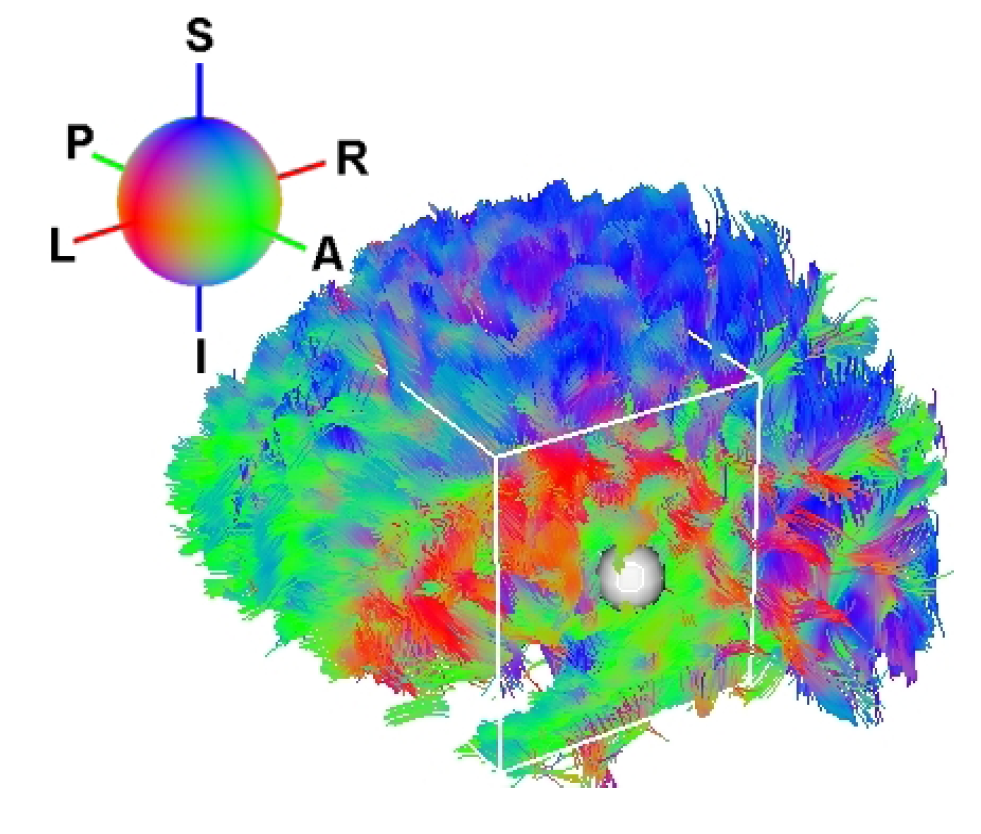Fiber Tracking: Description
Tractography, or fiber tracking, is a process which runs at
the end of the DTI processing pipeline, in the DTI Track module of MedINRIA [2]. Among the numerous
available methods for tracking fibers, we chose a relatively fast
and easy to implement one [6] and show how the tracking
can be improved by our variational estimation combined
with regularization. Criteria for stopping the tracking are: a
threshold on FA (if FA is too low, the tracking is stopped)
and on the curvature (to forbid unlikely fibers having a high
curvature). Prior to the tracking, tensor fields are resampled to
obtain isotropic voxels: in general, the out-plane resolution
is very low (e.g., the brain dataset here) and interpolating
the tensors improves the regularity of the fibers. Resampling
is interpreted as a weighted mean with trilinear coefficients.
Such a mean is computed in the logarithmic domain and then
mapped back to the tensor space with the matrix exponential:

where wi are classical trilinear
weights. We showed in [7] that such an interpolation has good
practical properties in the context of DT-MRI, compared to a
Euclidean interpolation.
Screenshots

On this figure is shown an example of a set of fiber tracts reconstructed in MedINRIA. Fibers are
represented as colorized lines in the 3D view. The color characterize the direction of the fiber
(see the color sphere).
References
-
D. Ducreux,
P. Fillard,
D. Facon,
A. Ozanne,
J.-F. Lepeintre,
J. Renoux,
M. Tadié,
and P. Lasjaunias.
Diffusion Tensor Magnetic Resonance Imaging and Fiber Tracking in Spinal Cord Lesions: Current and Future Indications.
Neuroimaging Clinics of North America,
17(1):137-147,
February 2007.
[bibtex-entry]
-
Pierre Fillard,
Vincent Arsigny,
Xavier Pennec,
and Nicholas Ayache.
Clinical DT-MRI Estimation, Smoothing and Fiber Tracking with Log-Euclidean Metrics.
IEEE Transactions on Medical Imaging,
26(11):1472-1482,
November 2007.
Note: PMID: 18041263.

 [bibtex-entry]
[bibtex-entry]
-
Denis Ducreux,
Jean-Francois Lepeintre,
Pierre Fillard,
C. Loureiro,
Marc TadiÄ(c),
and Pierre Lasjaunias.
MR diffusion tensor imaging and fiber tracking in 5 spinal cord astrocytomas.
AJNR Am J Neuroradiol,
27(1):214-6,
January 2006.
Keyword(s): Adult,
Astrocytoma,
diagnosis,
Diffusion Magnetic Resonance Imaging,
Female,
Humans,
Image Processing Computer-Assisted,
Imaging Three-Dimensional,
Male,
Nerve Fibers,
pathology,
Spinal Cord,
pathology,
Spinal Cord Neoplasms,
diagnosis.
[Abstract] [bibtex-entry]
-
J Renoux,
D Facon,
P Fillard,
I Huynh,
P Lasjaunias,
and D Ducreux.
MR diffusion tensor imaging and fiber tracking in inflammatory diseases of the spinal cord.
AJNR Am J Neuroradiol,
27(9):1947-51,
October 2006.
Keyword(s): Adult,
Anisotropy,
Diagnosis Differential,
Diffusion Magnetic Resonance Imaging,
Female,
Humans,
Image Enhancement,
Image Processing Computer-Assisted,
Male,
Middle Aged,
Multiple Sclerosis,
diagnosis,
Myelitis,
diagnosis,
Myelitis Transverse,
diagnosis,
Nerve Fibers,
pathology,
Neurologic Examination,
Prospective Studies,
Reference Values,
Sarcoidosis,
diagnosis,
Spinal Cord,
pathology.
[Abstract] [bibtex-entry]
-
D. Facon,
A. Ozanne,
P. Fillard,
J.-F. Lepeintre,
C. Tournoux-Facon,
and D. Ducreux.
MR Diffusion Tensor Imaging and Fiber Tracking in Spinal Cord Compression.
American Journal of Neuroradiology (AJNR),
26:1587-1594,
2005.
[bibtex-entry]
-
P. Fillard and G. Gerig.
Analysis Tool For Diffusion Tensor MR.
In Proc. of MICCAI'03, Part II,
volume 2879 of LNCS,
pages 979-980,
November 2003.
Springer.
[bibtex-entry]
-
Vincent Arsigny,
Pierre Fillard,
Xavier Pennec,
and Nicholas Ayache.
Log-Euclidean Metrics for Fast and Simple Calculus on Diffusion Tensors.
Magnetic Resonance in Medicine,
56(2):411-421,
August 2006.
Note: PMID: 16788917.

 Keyword(s): DT-MRI,
Tensors,
Riemannian geometry,
Lie groups,
interpolation,
Log-Euclidean metrics.
[bibtex-entry]
Keyword(s): DT-MRI,
Tensors,
Riemannian geometry,
Lie groups,
interpolation,
Log-Euclidean metrics.
[bibtex-entry]
